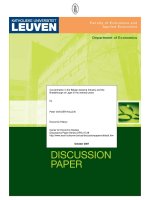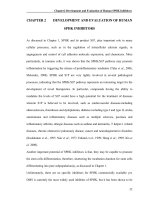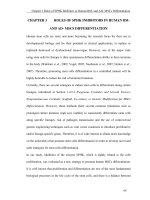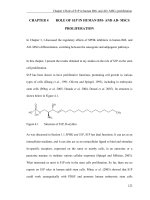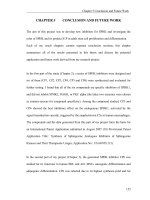Morphological hormonal and genetical analyses of early in vitro flowering in dendrobium chao praya smile
Bạn đang xem bản rút gọn của tài liệu. Xem và tải ngay bản đầy đủ của tài liệu tại đây (9.52 MB, 218 trang )
MORPHOLOGICAL, HORMONAL AND GENETICAL
ANALYSES OF EARLY IN VITRO FLOWERING IN
DENDROBIUM CHAO PRAYA SMILE
HEE KIM HOR
NATIONAL UNIVERSITY OF SINGAPORE
2010
MORPHOLOGICAL, HORMONAL AND GENETICAL
ANALYSES OF EARLY IN VITRO FLOWERING IN
DENDROBIUM CHAO PRAYA SMILE
HEE KIM HOR
(M. Sc.)
A THESIS SUBMITTED FOR THE DEGREE OF
DOCTOR OF PHYLOSOPHY
DEPARTMENT OF BIOLOGICAL SCIENCES
NATIONAL UNIVERSITY OF SINGAPORE
2010
i
ACKNOWLEDGEMENT
I am heartily thankful to my supervisor, A/P Loh Chiang Shiong and A/P Yeoh Hock
Hin, whose encouragement, guidance and support from the initial to the final level
enabled me to develop an understanding of the subject.
I am grateful to Mrs. Ang for her technical assistance; to Ping Lee and Madam Loy for
their help and guidance on microtomy; to Kishor and Chye Fong for their precious advice
on HPLC; to Say Tin for her technical assistance on ESI-MS/MS.
I owe my deepest gratitude to Sai Mun for his selfless sharing of knowledge and
materials of molecular work.
My heart-felt thanks to my lab-mates and friends Wee Kee, Teng Seah, Carol, Daphne,
Jacqueline, Baidah, Sean, Edwin and Reena for their help, advice, encouragement and
moral support.
I would like to extend my thanks to my family for their continuous support; to my brother
Gasi, especially, for his concern, understanding and continuous encouragement and
motivation throughout the course of this project.
Lastly, I offer my regards and blessings to all of those who supported me in any respect
during the completion of the project.
ii
CONTENT
Page
ACKNOWLEDGEMENT i
CONTENTS ii
SUMMARY vi
LIST OF TABLES viii
LIST OF FIGURES x
LIST OF ABBREVIATIONS xiv
1 INTRODUCTION 1
2 LITERATURE REVIEW 3
2.1 Phase change and Flowering 3
2.2 Factors regulating flowering 4
2.2.1 Plant growth regulators 4
2.2.2 Carbohydrates 8
2.2.3 Genetics 11
2.2.4 Florigen 12
2.3 Shoot apical meristem (SAM) at floral transition 14
2.3.1 Hormonal and genetic regulation of shoot apical
meristem (SAM) 15
2.3.2 KNOX homeobox gene 19
2.4 Cytokinins and their functions 21
2.4.1 Biosynthesis, translocation and perception of cytokinins 23
2.4.2 Cytokinins as long-distance signals 25
2.4.3 Cytokinins and auxin interactions 27
2.4.4 BA and its metabolism 29
2.4.5 Cytokinin oxidase/dehydrogenase, CKX (EC 1.5.99.12) 30
2.5 Flower development in plant 33
2.5.1 Control of flower size and color 34
2.5.2 Chalcone synthase, CHS (EC 2.3.1.74) 35
iii
2.6 In vitro flowering 37
2.6.1 In vitro flowering in non-orchidaceous plants 37
2.6.2 In vitro flowering in orchids 39
3 EARLY IN VITRO FLOWERING AND SEED PRODUCTION IN
CULTURE FOR DENDROBIUM CHAO PRAYA SMILE 42
3.1 Introduction 42
3.2 Materials and methods 43
3.2.1 Plant materials, culture media and culture conditions 43
3.2.2 Effects of coconut water and sucrose on flowering
induction 44
3.2.3 Sporad analysis of pollinia 44
3.2.4 Germination of pollen grains in vitro 44
3.2.5 In vitro pollination and seed production in culture 45
3.3 Results 45
3.3.1 Inflorescence induction in vitro 45
3.3.2 Effects of coconut water and sucrose on flowering
induction 52
3.3.3 Pollen and female reproductive organs 59
3.3.4 Sporad analysis and germination of pollen grains 64
3.3.5 Seed production in culture 64
3.4 Discussion 68
3.5 Concluding remarks 74
4 MORPHOLOGICAL CHANGES IN DENDROBIUM CHAO PRAYA
SMILE DURING INDUCTION OF FLOWERING AND DEVELOPMENT
OF IN VITRO FLOWERS 75
4.1 Introduction 75
4.2 Materials and methods 76
4.2.1 Plant materials, culture media and culture conditions 76
4.2.2 Histological analysis 77
4.2.3 Morphological measurement 77
iv
4.2.4 Analysis of development and color segregation of in vitro-
developed flowers 79
4.2.5 Cloning of D. Chao Praya Smile knox (DCPSknox) and
CHS (DCPSCHS) genes 79
4.2.6 Gene expression analysis by semi-quantitative RT-PCR 80
4.3 Results 82
4.3.1 Morphological changes in D. Chao Praya Smile cultures
at various stages of flowering induction 82
4.3.2 Morphological changes in the shoot apex 86
4.3.3 Cloning and expression of DCPSknox in D. Chao
Praya Smile 86
4.3.4 Analyses of development and color segregation of
in vitro-developed flowers 89
4.3.5 Cloning and expression of DCPSCHS in D. Chao
Praya Smile 95
4.4 Discussion 99
4.5 Concluding remarks 109
5 CHANGES IN CYTOKININS AND IAA CONTENTS IN FLOWERING-
INDUCED DENDROBIUM CHAO PRAYA SMILE 110
5.1 Introduction 110
5.2 Materials and methods 111
5.2.1 Plant materials for the analyses of cytokinins and IAA 111
5.2.2 Cytokinin and IAA extraction and separation by high
performance liquid chromatography (HPLC) 112
5.2.3 Quantification of cytokinins and IAA by electrospray
ionization mass spectrometry (ESI-MS/MS) 113
5.2.4 Cloning of D. Chao Praya Smile CKX (DCPSCKX) gene 114
5.2.5 Gene expression analysis by semi-quantitative RT-PCR 115
5.2.6 Effects of iP, iPR, IAA and TIBA on induction of flowering 116
5.3 Results 116
5.3.1 Retention times for the cytokinins and IAA separated by
HPLC 116
5.3.2 Quantification of cytokinins and IAA by ESI-MS/MS 119
5.3.3 Changes in cytokinins and IAA at different growth stages 124
5.3.4 Changes in cytokinins and IAA in various plant tissues 133
v
5.3.5 Cloning and expression of DCPSCKX in D. Choa Praya
Smile 143
5.3.6 Effects of iP, iPR, IAA and TIBA on induction of flowering 148
5.3.7 Expression of DCPSknox and DCPSCKX in shoot apices
of plantlets treated with BA, iP, iPR, IAA and TIBA 148
5.4 Discussion 153
5.5 Concluding remarks 162
6 CONCLUSION 164
REFERENCES 169
APPENDIX 194
vi
SUMMARY
Dendrobium Chao Praya Smile was induced to flower in a two-layer (a Gelrite-
solidified medium topped with a layer of liquid medium of the same composition and
volume) medium within 6 months from seed germination using BA. The functionality of
the in vitro-developed flowers was verified through sporad analysis and pollen grain
germination tests. The in vitro-developed flowers were able to form seedpods and
produce viable seeds upon self-pollination. With successful seed production in culture,
the plantlets could complete a life cycle entirely in vitro in about 11 months,
approximately one-third of the time in field-grown plants.
Histological analysis revealed that floral transition, as indicated by bolting, in D.
Chao Praya Smile took place 54 days after growing in a BA-containing liquid medium.
Subsequently, floral buds developed on the plantlets. During floral transition, the
expression of DCPSknox, a gene involved in maintaining the indeterminacy of shoot
apical meristem, was found to decrease. In in vitro-developed flowers, segregation of
colors was observed - 4 types of flowers with different intensities of pink coloration were
produced. It was possible that color segregation was naturally occurring as it was found
that BA treatment did not affect the expression of DCPSCHS, a key gene involved in
anthocyanin biosynthesis, in the plantlets. One-third of the flowers produced in vitro were
found to be incomplete with missing or defective floral organs.
Using HPLC-ESI-MS/MS, changes in cytokinin and IAA contents were analyzed
in flowering-induced D. Chao Praya Smile at different growth stages as well as in
different tissues during floral transition. It was found that iPR significantly increased in
the plantlet and shoot apex at floral transition. Higher cytokinin/IAA ratios were also
vii
observed in the plantlet and shoot apex at floral transition. Hence, we propose that the
endogenous cytokinin/IAA ratio, and not the absolute amount of cytokinins, which
determines flowering in D. Chao Praya Smile. The inductive and inhibitory effects of iPR
and IAA, respectively, on the flowering in D. Chao Praya Smile were also verified. A
fragment of DCPSCKX, a gene involved in cytokinin homeostasis, was cloned and its
expression was found to be strongly stimulated by BA treatment. Finally, a model of
mechanisms underlying the BA-induction of flowering in D. Chao Praya Smile was
proposed.
viii
LIST OF TABLES
Table Page
3.1 Inflorescence induction and flower development in D. Chao Praya
Smile. 48
3.2 Effects of BA on early inflorescence induction in D. Chao Praya
Smile. 49
3.3 Effects of BA on flowering induction in D. Chao Praya Smile. 50
3.4 Effects of plantlet selection on the percentage of inflorescence
induction in D. Chao Praya Smile. 51
3.5 Characteristic of field-grown and in vitro D. Chao Praya Smile
plants at flowering. 53
3.6 Effects of coconut water (CW) in the culture medium on flowering
induction in D. Chao Praya Smile. 55
3.7 Characteristics of D. Chao Praya Smile plantlets after 9 weeks of
growth in BA-free liquid media containing various concentrations
of CW. 57
3.8 Characteristics of D. Chao Praya Smile plantlets after 9 weeks of
growth in liquid media containing various concentrations of CW
and 11.1 µM of BA. 58
3.9 Characteristics of D. Chao Praya Smile plantlets after 9 weeks of
growth in BA-free liquid media containing various concentrations
of sucrose. 61
3.10 Characteristics of D. Chao Praya Smile plantlets after 9 weeks of
growth in liquid media containing various concentrations of sucrose
and 11.1 µM of BA. 62
3.11 Sporad formation and in vitro germination of pollen grains derived from
flowers of field-grown plants and in vitro-developed flowers. 65
4.1 Characteristics of D. Chao Praya Smile plantlets cultured in
liquid KC medium with various concentrations of BA for 54 days. 85
5.1 Precursor-to-product ion transitions used in the quantification
of cytokinins and IAA in D. Chao Praya Smile by ESI-MS/MS. 118
ix
5.2 Effects of cytokinins (iP and iPR), auxin (IAA) and auxin transport
inhibitor (TIBA) on flowering induction in D. Chao Praya Smile. 149
5.3 Characteristics of D. Chao Praya Smile plantlets after growing in
liquid media supplemented with BA (11.1 µM), iP (22.2 µM), iPR
(22.2 µM), IAA (0.5 µM) + BA (11.1 µM) or TIBA (2 µM) for 54 days. 151
x
LIST OF FIGURES
Figure Page
3.1 In vitro flowering in D. Chao Praya Smile. 46
3.2 Comparison of flowers and leaf epidermal peels of D. Chao Praya
Smile grown in field and in culture. 54
3.3 Morphology of D. Chao Praya Smile plantlets after 9 weeks of growth
in liquid media containing various concentrations of CW with or
without BA (11.1 µM). 56
3.4 Morphology of D. Chao Praya Smile plantlets after 9 weeks of growth
in liquid media containing various concentrations of sucrose with or
without BA (11.1 µM). 60
3.5 Comparison of pollinia and female reproductive organs of D. Chao
Praya Smile grown in field and in culture. 63
3.6 Sporads and in vitro pollen grain germination. 66
3.7 Seedpod development and seed production in culture. 67
3.8 Comparison of durations between conventional orchid breeding and
method of seed production in culture. 73
4.1 Median longitudinal section through the apex of a D. Chao Praya
Smile plantlet. 78
4.2 Various tissues of a D. Chao Praya Smile plantlet. 81
4.3 Morphology of non-induced and BA-induced (11.1 µM) D. Chao
Praya Smile cultures at different days after culture. 83
4.4 Morphology of D. Chao Praya Smile plantlets grown in liquid
media containing various concentrations of BA for 54 days. 84
4.5 Median longitudinal sections through apices of non-induced and
BA-induced D. Chao Praya Smile at different days after culture. 87
4.6 SAM height (a), width (b) and stem axis (c) of non-induced
(open circles) and BA-induced (closed circles) D. Chao Praya Smile
cultures at different days after culture. 88
xi
4.7 Nucleotide alignment of partial DCPSknox with knoxs from Dendrobium
grex Madame Thong-In (DOH1; AJ276389) and Dendrobium nobile
(Dnknox; AY608889). 90
4.8 Amino acid alignment of partial DCPSKNOX with KNOXs from
Dendrobium grex Madame Thong-IN (DOH1; CAB88029) and
Dendrobium nobile (Dnknox; AAT72917). 91
4.9 Expression of DCPSknox in D. Chao Praya Smile cultures at juvenile
(0, 20 and 38 days after culture), floral transition (54 days after
culture) and flowering (80 days after culture) stages. 92
4.10 Expression of DCPSknox in different tissues of non-induced and
BA-induced plantlets after 54 days of culture. 93
4.11 Analyses of development and color segregation of in vitro-developed
flowers of D. Chao Praya Smile. 94
4.12 Color segregation of D. Chao Praya Smile flowers developed in vitro. 96
4.13 Morphology of incomplete flowers produced in vitro. 97
4.14 Nucleotide alignment of partial DCPSCHS with CHSs from other
orchid species. 98
4.15 Amino acid alignment of partial DCPSCHS with CHSs from other
orchid species. 100
4.16 Expression of DCPSCHS in non-induced and BA-induced plantlets
after 54 days of culture. 101
5.1 Separation of cytokinins and IAA by HPLC. 117
5.2 Fragmentation patterns for labeled and unlabeled Z-type cytokinin
standards. 120
5.3 Fragmentation patterns for labeled and unlabeled iP-type cytokinin
standards. 121
5.4 Fragmentation patterns for labeled and unlabeled DHZ-type cytokinin
standards. 122
5.5 Fragmentation patterns for labeled and unlabeled BA and IAA standards. 123
xii
5.6 Level of total cytokinins (excluding BA) in non-induced (open symbols)
and BA-induced (closed symbols) D. Chao Praya Smile at different days
after culture. 125
5.7 Percentage composition of Z-, iP- and DHZ-type cytokinins in
non-induced (a) and BA-induced (b) D. Chao Praya Smile at
different days after culture. 126
5.8 Concentrations of zeatin (Z) (a), zeatin riboside (ZR) (b), zeatin-9-glucoside
(Z9G) (c) and zeatin riboside-5’-monophosphate (ZMP) (d) in non-induced
(open symbols) and BA-induced (closed symbols) D. Chao Praya Smile
at different days after culture. 127
5.9 Concentrations of isopentenyladenine (iP) (a), isopentenyladenosine (iPR)
(b), isopentenyladenine-9-glucoside (iP9G) (c) and isopentenyladenosine-
5’-monophosphate (iPMP) (d) in non-induced (open symbols) and
BA-induced (closed symbols) D. Chao Praya Smile at different days
after culture. 129
5.10 Concentrations of dihydrozeatin (DHZ) (a), dihydrozeatin riboside (DHZR)
(b), dihydrozeatin-9-glucoside (DHZ9G) (c) and dihydrozeatin riboside-
5’-monophosphate (DHZMP) (d) in non-induced (open symbols) and
BA-induced (closed symbols) D. Chao Praya Smile at different days after
culture. 130
5.11 Concentrations of benzyladenine (BA) (a) and indole-3-acetic acid (IAA)
(b) in non-induced (open symbols) and BA-induced (closed symbols)
D. Chao Praya Smile at different days after culture. 131
5.12 Ratios of total cytokinins (excluding BA) to IAA (CKs/IAA) in
non-induced (open symbols) and BA-induced (closed symbols)
D. Chao Praya Smile at different days after culture. 132
5.13 Relative distances of various tissues in D. Chao Praya Smile plantlet. 134
5.14 Distribution of Z- (a), iP- (b) and DHZ-type (c) cytokinins in various
tissues of non-induced (dark grey bars) and BA-induced (light grey
bars) D. Chao Praya Smile plantlets during floral transition. 135
5.15 Concentrations of cytokinins and IAA in the shoot apices of non-induced
and BA-induced D. Chao Praya Smile plantlets during floral transition. 137
5.16 Concentrations of cytokinins and IAA in the leaves of non-induced
and BA-induced D. Chao Praya Smile plantlets during floral transition. 138
xiii
5.17 Concentrations of cytokinins and IAA in the stems and leaf bases of
non-induced and BA-induced D. Chao Praya Smile plantlets during
floral transition. 139
5.18 Concentrations of cytokinins and IAA in the stem bases of non-induced
and BA-induced D. Chao Praya Smile plantlets during floral transition. 140
5.19 Concentrations of cytokinins and IAA in the roots of non-induced
D. Chao Praya Smile plantlets after being grown in liquid medium for
54 days. 141
5.20 Ratios of total cytokinins (excluding BA) to IAA in BA-induced (closed
circles) and non-induced (open circles) D. Chao Praya Smile plantlets
at various distances from the shoot apices after 54 days of culture. 142
5.21 Nucleotide alignment of partial DCPSCKX with CKXs from D. “Sonia”
(DSCKX1; AJ294542) and D. huoshanense (DhCKX; EF213077). 144
5.22 Amino acid alignment of partial DCPSCKX with CKXs from D. “Sonia”
(DSCKX1; CAC17752) and D. huoshanense (DhCKX; ABM98099). 145
5.23 Expression of DCPSCKX at various growth stages in D. Chao Praya Smile. 146
5.24 Expression of DCPSCKX in different tissues of BA-induced D. Chao
Praya Smile plantlets at floral transition. 147
5.25 Morphology of D. Chao Praya Smile plantlets after growing in liquid
medium supplemented with BA (11.1 µM), iP (22.2 µM), iPR (22.2 µM),
IAA (0.5 µM) + BA (11.1 µM) or TIBA (2 µM) for 54 days. 150
5.26 Expression of DCPSknox and DCPSCKX in shoot apices of D. Chao Praya
Smile plantlets treated with various plant growth regulators after 54 days
of culture. 152
6.1 Proposed mechanisms underlying the BA-induction of in vitro flowering
in D. Chao Praya Smile. 166
xiv
LIST OF ABBREVIATIONS
BA 6-benzyladenine
CHS Chalcone synthase
CKX Cytokinin oxidase/dehydrogenase
CW Coconut water
DHZ Dihydrozeatin
DHZR Dihydrozeatin riboside
DHZ9G Dihydrozeatin-9-glucoside
DHZMP Dihydrozeatin riboside-5’-monophosphate
DW Dry weight
ESI Electrospray ionization
FW Fresh weight
GA Gibberellic acid
HPLC High performance liquid chromatography
IAA Indole-3-acetic acid
iP Isopentenyladenine
iPR Isopentenyladenosine
iP9G Isopentenyladenine-9-glucoside
iPMP Isopentenyladenosine-5’-monophosphate
IPT Adenosine phosphate-isopentenyltransferase
LD Long-day
MS Mass spectrometry
RT-PCR Reverse transcription polymerase chain reaction
SAM Shoot apical meristem
SD Short-day
TIBA 2,3,5-triiodobenzoic acid
tZ trans-zeatin
Z Zeatin
ZR Zeatin riboside
Z9G Zeatin-9-glucoside
ZMP Zeatin riboside-5’-monophosphate
1
Chapter 1
INTRODUCTION
Orchids are grown mainly for the beauty of their flowers. The plants have been
cultivated and marketed globally as potted plants and cut flowers (Winkelmann et al.,
2006). Despite the increasing demand for these plants, it takes years before flowers can
be produced in orchid plants, due to the presence of a long juvenile vegetative phase
(Hew and Yong, 1994). For instance, the juvenile phase of Dendrobium hybrids before
first flowering can range from 3.5 to 7.5 years (Wee, 1971). Therefore, various tissue
culture methods have been developed to shorten the juvenile phase in orchids, and to
induce flowering in vitro in order to achieve flowering in a shorter period of time. To
date, flowering in vitro has been successfully induced in Cymbidium (Kostenyuk et al.,
1999; Chang and Chang, 2003), Dendrobium (de Melo Ferreira et al., Hee et al., 2007;
Sim et al., 2007; Tee et al., 2008; Wang et al., 2009), Phalaenopsis (Duan and Yazawa,
1995) and ×Doriella (Duan and Yazawa, 1994) orchids. Cytokinins, such as BA (6-
benzyladenine) and thidiazuron, were used in the tissue culture methods for flowering
induction.
Even with the successful induction of in vitro flowering in some orchid species,
the mechanisms underlying the flowering induction process remained elusive. In other
plant species such as Arabidopsis thaliana, Nicotiana tabacum and Sinapis alba,
cytokinins have always been suggested and implicated as important factors relating to
floral transition (Chaudhury et al., 1993; Dewitte et al., 1999; Bernier et al., 2002). In
these plant species, cytokinin content in the plant would be markedly elevated during
floral transition (Chaudhury et al., 1993; Dewitte et al., 1999; Bernier et al., 2002).
2
Moreover, cytokinins have been proposed as the mobile physiological signals that trigger
the initiation of flowering in S. alba upon long-day induction (Bernier et al., 1993). In
orchids, the physiological importance of cytokinins in flowering was mainly observed in
field experiments involving foliar spray or injection of cytokinins (Sakai et al., 2000;
Blanchard and Runkle, 2008).
The objective of this project was to investigate the morphological, hormonal and
genetical changes in the early in vitro flowering in Dendrobium Chao Praya Smile. D.
Chao Praya Smile was induced to flower in vitro using BA. Viable orchid seeds were
produced in culture by self-pollinating the in vitro-developed flowers. At different growth
stages of flowering induction, morphological changes in the shoot apical meristem of D.
Chao Praya Smile were studied to determine the timing of floral transition in the
plantlets. The development of the flowers produced in vitro was observed for color
segregation. The expression of DCPSCHS (anthocyanin biosynthetic gene) was
investigated in order to find out if BA treatment has caused color segregation in the
flowers developed in vitro. The in vitro flowering of D. Chao Praya Smile was then used
as a model system to investigate the changes in cytokinin and indole-3-acetic acid (IAA)
content as well as the expression of DCPSCKX (gene of cytokinin
oxidase/dehydrogenase) at various growth stages, especially during floral transition. It
was hoped that the information obtained from the study will contribute towards greater
understanding of the involvement of cytokinins, IAA and DCPSCKX in the in vitro
flowering in D. Chao Praya Smile.
3
Chapter 2
LITERATURE REVIEW
2.1 Phase change and flowering
Plants pass through a series of distinct developmental phases during their growth.
In higher plants, these developmental phases take place in the shoot apex. The shoot apex
undergoes three distinct phases during its post-embryonic development: a juvenile
vegetative phase, an adult vegetative phase and a reproductive phase (Poethig, 1990). The
transition from juvenile to adult vegetative phase usually occurs gradually and involves
subtle changes in the morphology and physiology of the shoot apex. On the other hand,
transition from vegetative to reproductive or flowering could be abrupt and noticeable
changes would occur at the shoot apex (Poethig, 1990). Flowering transition is a major
event in the life of a plant because the shoot apical meristem (SAM) will switch from leaf
production to the initiation of floral organ. Flowering is a process whereby leaf
development is suppressed and lateral buds differentiate as flowers of flower-bearing
branches (Poethig, 2003). A combination of environmental, developmental, hormonal
and genetic factors determines the eventual transition to flowering. To ensure
reproductive success, flowering transition will only take place when these factors are
most favorable. Since flowering leads to sexual reproduction, it is of paramount
importance in agriculture, horticulture and plant breeding. A number of studies have been
conducted to investigate factors that affect flowering transition in various plant species
(de Bouillé et al., 1989; Bernier et al., 1993).
Orchids have been marketed globally as cut flowers and potted flowering plants.
Like many other flowering plants, a juvenile phase exists in orchids. Flowering and
4
reproduction can only take place when the orchids have reached a certain size, sufficient
to maintain the energetic demands of flowering and seed production (Lopez and Runkle,
2005). When the plants have attained the competency to flower, environmental and
cultural factors can be provided to induce flowering.
2.2 Factors regulating flowering
2.2.1 Plant growth regulators
Plant growth regulators could control the entire development of a plant and its
interactions with external environment (Reski, 2006). Many studies have suggested that
cytokinins were direct or indirect factors that led to floral transition. They were shown to
increase progressively in the terminal buds of Pinus pinea from juvenile to adult phase
(Valdés, et al., 2004), indicating the importance of this plant growth regulator in
promoting sexual maturation. Similarly, increased endogenous cytokinin levels have also
been correlated to flowering in Sinapis alba (Bernier et al., 2002). In Arabidopsis
thaliana, cytokinin levels were found to increase in a mutant that flowered early
(Chaudhury et al., 1993). Furthermore, early flowering caused by the constitutive
expression of pea ABA-responsive 17 (ABR17) in Arabidopsis (Srivastava et al., 2006)
and Brassica napus (Dunfield et al., 2007) was attributed to increased cytokinin levels in
the plants.
Cytokinins in SAM were crucial for floral transition. Higher cytokinin levels were
detected in the apices of B. napus (de Bouillé et al., 1989), Chenopodium rubrum and
Chenopodium murale (Machácková et al., 1993) during floral transition. After long-day
(LD) induction of flowering in S. alba, the phloem sap feeding the shoot apex was found
5
to be enriched with isopentenyladenine (iP)-type cytokinins (Lejeune et al., 1994). The
accumulation of iP in SAM tissue in S. alba during floral transition has also been
demonstrated by Jacqmard et al. (2002). It was suggested that the increased iP in the
SAM could be either transported from leaf into the phloem or locally synthesized because
apical buds were capable of synthesizing cytokinins (Letham, 1994). Plasmodesmata are
membrane-lined channels that connect higher plant cells to form a functional intercellular
communication network of symplasm (Robards and Lucas, 1990). It was shown in S.
alba that the number of plasmodesmata was dramatically increased in the SAM following
LD induction of flowering (Ormenese et al., 2000). A similar increase in plasmodesmata
was observed when BA was applied to the plant (Ormenese et al., 2006). Therefore, it
was suggested that floral transition induced by LD was mediated by cytokinin. Although
endogenous cytokinins were important for floral transition, exogenous cytokinin
application did not cause flowering in S. alba, although it stimulated cell division
(Jacqmard et al., 1998) and transcription of the SaMADS gene (Bonhomme et al., 2000),
responses similar to those under LD induction. Therefore, it could be concluded that
endogenous cytokinin mobilization or synthesis was crucial in floral transition in S. alba.
Plant growth regulators also appeared to be important in the flowering of
Dendrobium orchids. It was postulated that photoperiod and low temperature that induced
flowering in Dendrobium orchids could be associated with changes in the concentrations
of endogenous plant growth regulators (Goh and Arditti, 1985). Furthermore, injection of
cytokinin into Dendrobium Jaquelyn Thomas “Uniwai Princess” has been shown to
increase the number of inflorescences (Sakai et al., 2000). Cytokinins have also been
shown to regulate inflorescence initiation of field grown Doritaenopsis and Phalaenopsis
6
orchids (Blanchard and Runkle, 2008). These orchids could be induced to flower earlier
with more inflorescences and flowers per plant when treated with foliar sprays containing
BA. Although BA promoted flowering in the orchids, it could not completely substitute
for inductive low temperature. Therefore, it was suggested that cytokinins promoted
flowering in orchids only when the environmental and cultural factors were in favor of
flowering (Blanchard and Runkle, 2008).
It is well known that flowering in Phalaenopsis hybrida requires a period of low
temperature (Hew and Yong, 1997). When subjected to high temperature, a condition not
favoring for floral transition, total cytokinins were reduced and glucoside cytokinins were
accumulated in the leaves of Phalaenopsis orchid (Chou et al., 2000). In contrast, the
levels of zeatin (Z), zeatin riboside (ZR) and dihydrozeatin (DHZ) were found to increase
under low temperature (Chou et al., 2000). This result might indicate that cytokinin
metabolism could be affected by temperature and that free base and cytokinin ribosides
might be related to floral transition (Chou et al., 2000). Although many studies have
indicated that cytokinins were important factors in flowering, the effect of cytokinins on
flowering induction in field-grown orchids was not consistent. BA application to field-
grown Miltoniopsis orchid hybrids was shown to promote the growth of new vegetative
shoots and reduced the number of plants with inflorescence (Matsumoto, 2006). The
reduction of flowering could be alleviated by the application of gibberellic acid (GA) in
the BA treated plants.
Ascorbic acid-deficient mutants of Arabidopsis were shown to flower early
irrespective of photoperiod when compared with the wild type (Kotchoni et al., 2009).
Conversely, flowering was delayed when the ascorbic acid content was artificially
7
increased. The effect of ascorbic acid on flowering could be related to plant growth
regulator-mediated signaling processes that regulate floral transition because ascorbic
acid could serve as cofactor for the synthesis of certain plant growth regulators (Barth et
al., 2006). Strigolactones, which are carotenoid-derived terpenoid lactones, were recently
suggested to play a role in inflorescence development by regulating axillary bud
outgrowth (Waldie et al., 2010).
It was difficult to draw a conclusion on which cytokinins were crucial in floral
transition because different cytokinins were predominant in different plant species
(Lejeune et al., 1988). For example, a significant increase in the endogenous
concentrations of isopentenyladenosine (iPR) was observed in the root and leaf tissues of
Arabidopsis upon flowering induction using tricontanol (He and Loh, 2002). In addition,
treating Arabidopsis plant with iPR was sufficient and effective to induce floral bud
formation (He and Loh, 2002). The finding was in line with Lejeune et al. (1988) who
reported that the root exudate of LD-induced S. alba was enriched with iPR. These
findings appeared to indicate that iPR was involved in floral transition.
The interplay between cytokinins and IAA could be more important than
cytokinins alone in regulating floral transition. A lower IAA/cytokinins ratio was
observed at flowering stage in T. recurvata which was caused by the enhancement of
cytokinins (Mercier and Endres, 1999). Similarly, flowering induction in longan
(Dimocarpus longan, Lour.) was found to be associated with elevated Z and ZR in the
buds and simultaneous decrease in the concentration of IAA, thereby creating a high
cytokinins/IAA ratio at floral transition (Hegele et al., 2008). In vitro flowering of
Dendrobium Second Love induced by thidiazuron was associated with increased iPR, ZR
8
and IAA in the shoots (de Melo Ferreira et al., 2006), creating a cytokinins/IAA ratio
close to 1. All these results indicated that it was not cytokinins, but the ratio of cytokinins
to IAA in the plant that was crucial in promoting floral transition.
2.2.2 Carbohydrates
Carbohydrates are important nutrients and energy sources in living organisms.
During plant growth and development, photoassimilates produced in the leaf are
translocated to different sinks for utilization or accumulation (Geiger, 1987). Sugars
could help to regulate the timing of developmental phase change from juvenile to
reproductive phases by ensuring an adequate supply of materials and energy for the
successful completion of such transition. It was suggested that increased carbohydrate
levels, especially sucrose, could promote flowering (Gibson, 2005).
It was shown in Arabidopsis that application of sucrose to the apical part of the
plant induced flowering in complete darkness (Roldán et al., 1999). In addition, late-
flowering ecotypes flowered with similar number of leaves as early-flowering ecotypes in
dark when treated with sucrose. It was suggested that rapid dark flowering of the late-
flowering ecotype was the result of sucrose availability at the aerial part of the plant
(Roldán et al., 1999). By comparing the flowering induction in wild-type Arabidopsis
and its starchless (pgm) and starch-in-excess (sex1) mutants, Corbesier et al. (1998)
indicated that an early and transient increase in carbohydrate export from leaves to
phloem was critical in floral transition. In Spathiphyllum, sucrose concentration was
significantly decreased in leaves during floral induction, which was speculated to be
transported from leaves to the SAM (Dewir et al., 2008). In the process of carbohydrate
9
export, sucrose transporter1 (SUT1) was shown to be crucial for efficient phloem loading
of sucrose in maize leaves (Slewinski et al., 2009). In sut1 mutants, phloem loading was
impaired and carbohydrates were accumulated in mature leaves, which subsequently led
to delayed flowering and stunted tassel development. The results therefore indicated that
phloem loading and sucrose transport were important in regulating floral transition and
reproductive development.
Photosynthetic activity increased in Zantedeschia leaves in response to GA-
stimulated flowering (Kozłowska et al., 2007), indicating a higher demand of
carbohydrate at floral transition. The study of carbohydrate mobilization in the
pseudobulb of Oncidium orchid has shown that mannan and pectin accumulated in the
pseudobulb were converted to starch during the emergence of the inflorescence, which
was subsequently degraded at floral development stage (Wang et al., 2008a). The study
also suggested that ascorbic acid, which was produced indirectly in the carbohydrate
metabolic pathway, could solubilize pectin into oligogalacturonides, which could in turn
function as signaling molecule in flowering induction (Wang et al., 2008a).
The importance of carbohydrate in promoting flowering was further implicated by
the involvement of carbohydrate metabolism enzymes during floral transition. Activity of
glyceraldehyde 3-phosphate dehydrogenase, a key enzyme in glycolysis, was shown to
fluctuate in shoot apical meristem of Brassica campestris during transition to flowering
(Orr, 1987). Such phenomenon probably indicated that carbohydrate oxidation was
involved during the transitional phase (Orr, 1987). In Arabidopsis thaliana, trehalose-6-
phosphate synthase, the enzyme that catalyzes the first step in trehalose synthesis, was
also found to be essential in floral transition (Van Dijken et al., 2004). Cell wall
